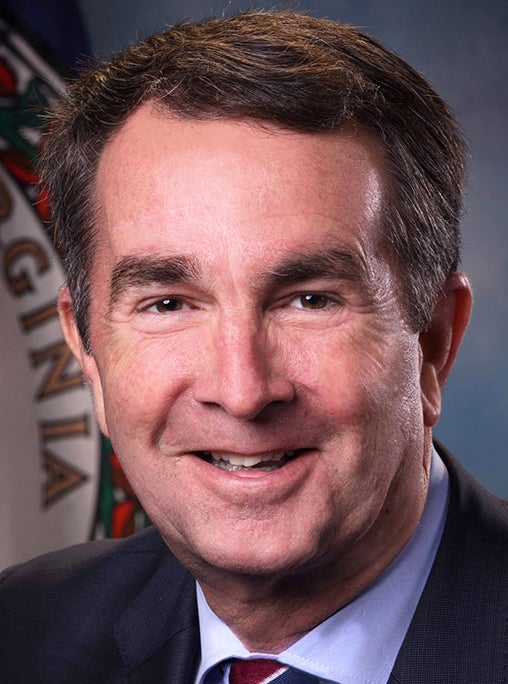Governor declares new, limited state of emergency
Outgoing Gov. Ralph Northam has declared a 30-day state of emergency to ease the burden on the state’s hospitals amid an unprecedented surge in hospitalizations due to COVID-19 and the highly-transmissible omicron variant.
The order, he said during his last COVID-19 press briefing, is designed to expand available hospital beds, as it allows the state health commissioner to waive normal bed licensing requirements to allow hospitals to increase their licensed bed capacity.
It also allows hospitals and nursing homes to increase their staffing by allowing providers with an out-of-state license to practice in Virginia, allows experienced physician assistants to practice without a written supervisory agreement, increases provider-to-patient ratios and provides certain liability protections to health care workers acting in good faith to protect patients. The state’s public health agencies will also have greater flexibility in responding to the pandemic.
The state on Jan. 7 reached what had been a record-high of 3,329 hospitalizations since the start of the pandemic, with COVID-19 hospitalizations up 194% in the past month, according to the Virginia Hospital and Healthcare Association.
Since then, the state reached a new high of 3,681 people hospitalized as of Jan. 10 with COVID-19 across the state. It is also reporting 567 people hospitalized in intensive care units and 314 people who are on ventilators.
Hospitalizations continue to increase at Sentara Obici Hospital in Suffolk, with 73 confirmed COVID-19 patients as of Jan. 10, representing 37% of its patients. Among its hospitals in the South Hampton Roads region — inclusive of Sentara Albemarle Medical Center in Elizabeth City, North Carolina — 475 people are hospitalized with COVID-19.
VHHA noted that the surge was the state’s fifth of the pandemic, with the previous four in spring 2020, summer 2020, fall and winter 2020-2021 and summer 2021.
Northam said thinking needs to shift to study not only the number of people who get COVID-19, but also the number of people who are hospitalized with the virus.
“Fortunately, the omicron variant appears to cause symptoms that are less serious than previous variants,” Northam said, “especially for people who are unvaccinated, and the data is clear.”
But he also noted how much more contagious the omicron variant is and that its impact is straining hospitals and their employees.
“That means that even though the symptoms are less severe, if more people get sick, more people are going to need to go to the hospital,” Northam said. “And that is what we’re now seeing around the country and especially right here in Virginia. It’s causing a real strain on the people who work in hospitals.
“Doctors and nurses have worked tirelessly for 22 months to care for people who have gotten sick. I say tirelessly, but it’s not really the right word, because they are tired, they’re exhausted and they’re burned out. That’s why it’s so important for all of us to help them.”
He called for people to go to the hospital only if necessary in order to relieve pressure on hospital workers.
Northam said his executive order to declare a limited state of emergency will give hospitals staffing flexibility, would allow for an increase in telehealth use and expand who among medical professionals could administer COVID-19 vaccines.
He said the state of emergency is not restrictive and will relax regulations to allow people to get more care more quickly, but even with the surge in cases, the COVID-19 vaccines have mitigated the severity of the virus and the omicron variant, in particular.
“It is painful to see COVID case numbers rising once again,” Northam said. “This started around Thanksgiving, and cases are now very high, higher than they have ever been. … I want everyone to understand that today’s situation is very different than a year ago. Case numbers are high, and that’s a reason for concern, but not a reason for panic.”
Northam touted the state’s vaccination rates, with nearly 90% of the state’s adults having received at least one dose of a COVID-19 vaccine and 68.1% of the state’s eligible population (ages 5 and up) being fully vaccinated, and more than 2.2 million having received a booster or third dose. Among the Western Tidewater Health District localities of Suffolk, Franklin, Isle of Wight County and Southampton County, along with Surry County in the Crater Health District, vaccination rates for the fully vaccinated range from 50.2% in Southampton to 65% in Isle of Wight. In Suffolk, it’s 58.3%.
“As a Commonwealth, it has been a long 22 months for all of us,” Northam said. “We’ve been worried, we’ve been scared, angry, sad, and a lot more sometimes, all at once. It has been a roller coaster, and we’re not built for this kind of uncertainty for this long. It has been hard on everyone, to include our children and our families.”


